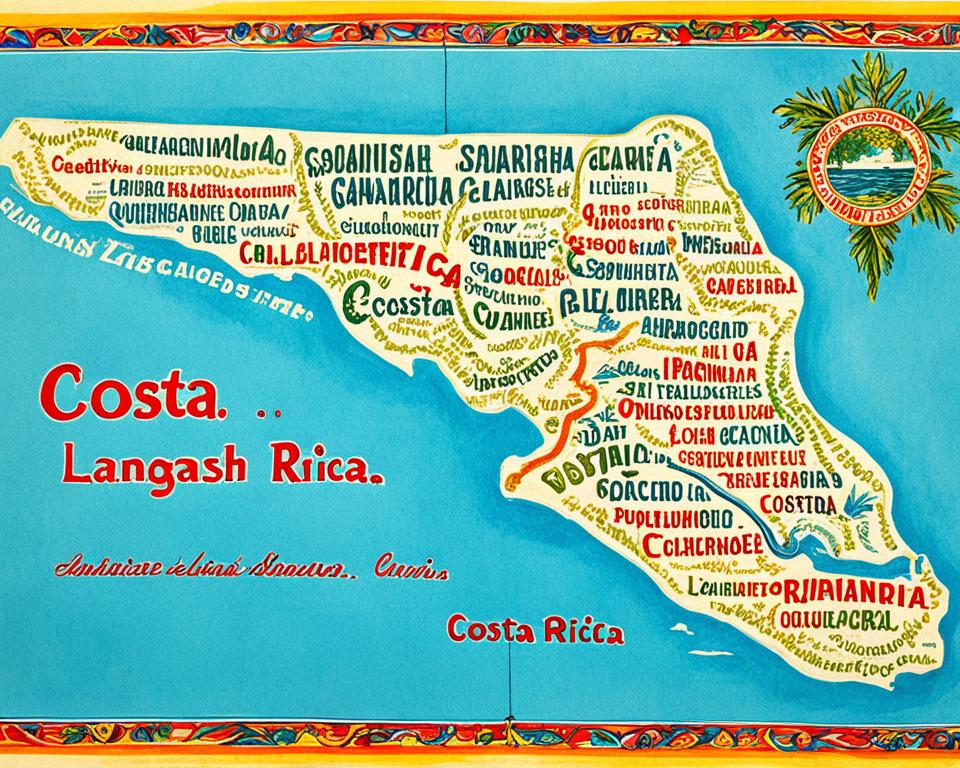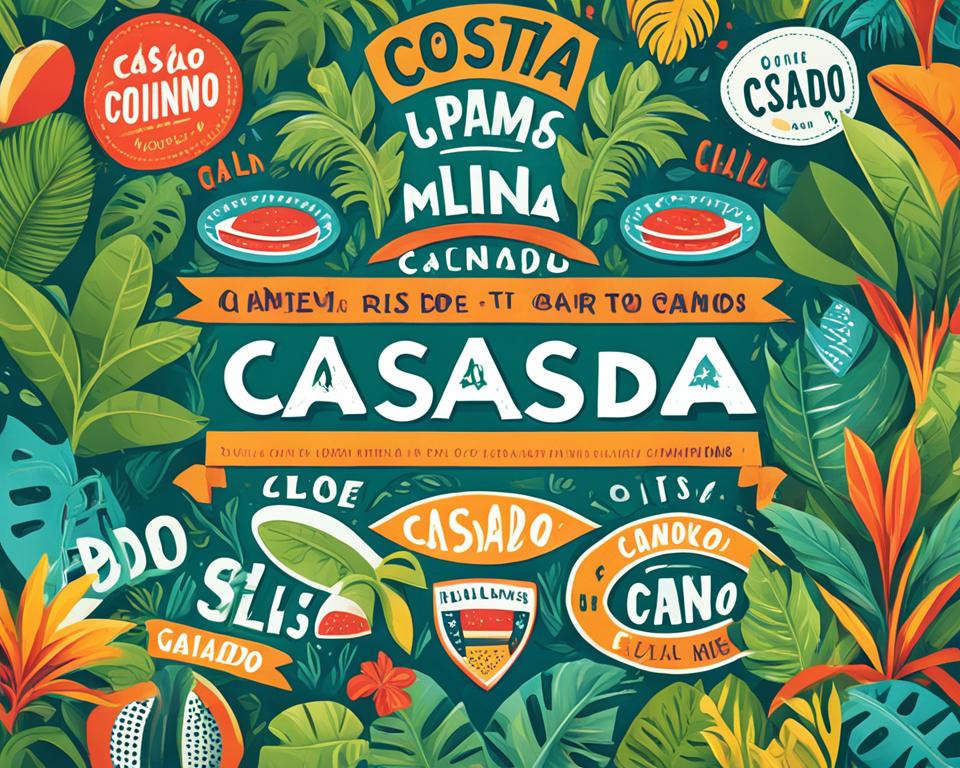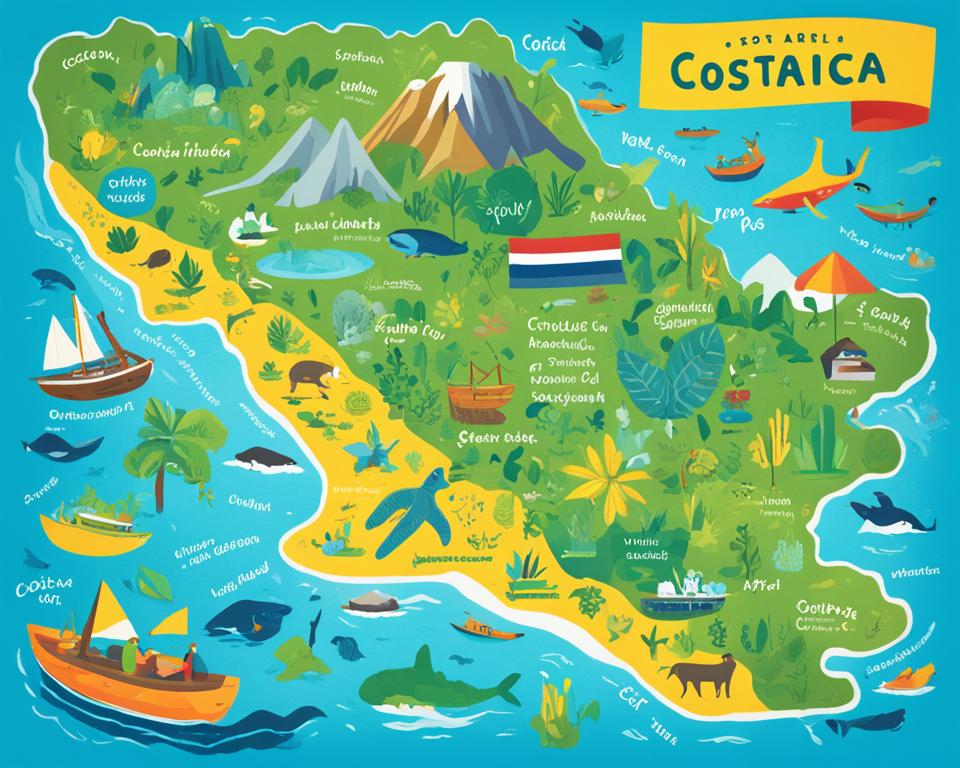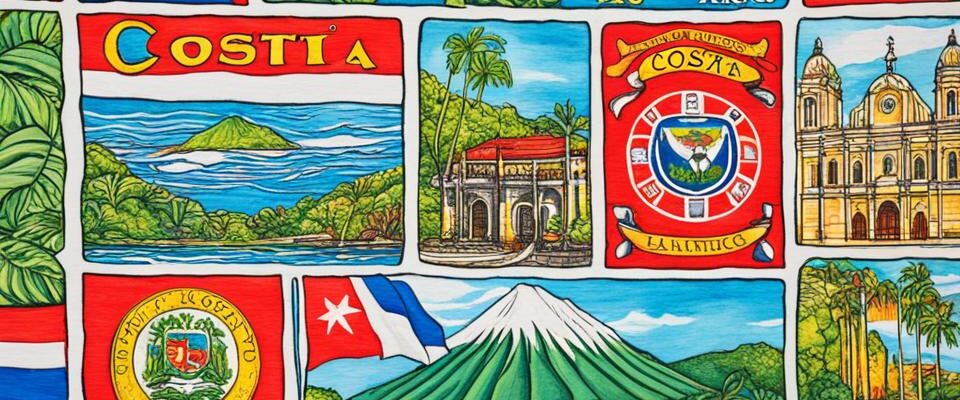Costa Rica’s Official Language: What You Need to Know
Costa Rica is famous for its rich culture, beautiful nature, and strong economy. At its core is its official language, Spanish. This language has been key in Costa Rica since the Spanish colonization in the 16th century. But, the country’s language scene is more complex, with many indigenous languages, foreign tongues, and regional dialects adding to its unique culture.
Key Takeaways
- Spanish is the official and main language in Costa Rica, tracing back to the Spanish colonization.
- Costa Rica is home to at least five living indigenous languages, including Maléku, Cabécar, Bribri, Guaymí, and Buglere, all from the Chibcha family.
- There’s a big English-speaking group, with over 20,000 Americans, 10,000 Canadians, and 6,000 British people living in Costa Rica.
- Costa Rica’s language scene is diverse, with languages like German, Italian, French, and Chinese also present.
- The phrases “Pura Vida” and “Tico/Tica” show the unique identity and lively culture of Costa Rica.
Official Language: Spanish
Since the 16th century, Spanish has been the main language in Costa Rica. The Costa Rican Spanish variety is a type of Central American Spanish. It comes from the Castilian Spanish the Spanish colonizers brought. Over time, this language has become a big part of Costa Rica’s culture.
Roots in Spanish Colonization
The Spanish arrived in Costa Rica in the early 1500s with the Castilian dialect. This Spanish became the main language and changed into the Costa Rican Spanish we see now. It took on local sounds and words from the indigenous people and other groups that moved there.
Castilian Spanish Influence
The Castilian Spanish has greatly shaped Costa Rican Spanish. It has its own features like the “double-R” sound change and the way it ends with /n/. Also, “usted” is more commonly used than “tú” or “vos”.

Costa Rican Spanish also has tiquismos, special words and sayings. Examples are “ticos” and phrases like “esse chante es muy tuanis” or “¡Qué taco me dio esa vara!”. These show how Castilian Spanish has changed over time in Costa Rican culture.
Indigenous Languages of Costa Rica
Costa Rica has more than just Spanish as its official language. It’s home to many indigenous languages from the Chibcha family. These languages are spoken by the descendants of pre-Columbian peoples. They are key to keeping the country’s language and culture alive.
Maléku Language
About 800 people in the northeastern Alajuela Province speak Maléku. It’s an important language recognized by the government. Maléku is part of the Chibcha family, showing Costa Rica’s rich language diversity.
Cabécar Language
In the Talamanca mountains and southern Pacific, the Cabécar language is spoken. It’s deeply connected to the Cabécar people’s culture and traditions. They’ve lived in these areas for hundreds of years.
Bribri Language
The Bribri language is also from the Chibcha family and is in the southern Pacific of Costa Rica. The Bribri people keep their language and traditions alive. They are a vital part of Costa Rica’s diverse language scene.
Languages like Guaymí, Terraba, and Boruca add to Costa Rica’s linguistic diversity. They highlight the country’s rich cultural heritage. These languages prove the strength of its native peoples.

Regional Dialects and Variations
Costa Rica is known for its rich variety of Spanish dialects and variations. These differences in how people speak show the cultural mix that has shaped Spanish in Costa Rica. Knowing about these dialects helps us see the unique language scene of this Central American country.
In the Central Valley, including San José, the Spanish is more like Bogotá’s, thanks to Castilian influence. The Pacific side has ties to Nicaragua, while the Caribbean coast has been shaped by Creole English. These differences make Costa Rican Spanish rich and diverse.
Costa Rican Spanish is known for its unique dialects and variations. For example, some areas have a special way of pronouncing the “r” sound. Others often drop the “s” or “d” sounds at the end of words. Also, the final “n” might sound like /ng/ instead of /n/.
But it’s not just Spanish that makes Costa Rica’s language scene vibrant. The country also has indigenous languages like Malecu, Cabecar, and Bribri. These languages are mainly spoken in rural areas and add to the country’s linguistic diversity.
In conclusion, Costa Rica’s Spanish dialects and variations show its rich culture and language’s dynamic nature. Understanding these differences helps visitors and locals appreciate the unique language scene of Costa Rica.
Costa Rican Spanish Slang
Explore the colorful world of Costa Rican Spanish, where official Spanish meets local slang. This mix, known as “Tico” language, shows off the country’s unique culture and identity. It gives visitors a peek into the heart of central American Spanish.
Tico Expressions and Phrases
“Pura Vida” is a key phrase in Costa Rican slang. It can be a greeting, a farewell, or a way to say thanks. It’s all about living life easy and free, loved by locals and tourists.
“Mae” is another slang term, used by young men as a filler word. It’s like saying “dude” or “man.” “Tuanis” means something is cool or good in Costa Rican slang.
“Diay” and “Idiay” come from “de ahí” and “y de ahí” in Spanish. They’re used as greetings or to ask someone to share more. They also express feelings and ideas.
Costa Rica has fun nicknames for cities like “Chepe” for San José and “Moncho” for San Ramón. These names show the unique flavor of the Spanish spoken there.
When exploring Costa Rica, know when to use slang like “Despiche.” It’s a term for a certain body part and should be used carefully. Other slang, like “Mejenga” for soccer, “Jupa” for head, and “Ruco” for horse or old man, shows the local culture.

Getting into the world of Costa Rican slang helps visitors connect deeply with the locals. It’s a way to understand the culture and people better.
Costa Rica’s Official Language
Spanish is the official and national language of Costa Rica, as stated in the constitution. It is the main language spoken in the country. Spanish connects people and is a key part of Costa Rican culture and identity. It shows the language’s deep historical and cultural importance in Costa Rica.
Over 83% of Costa Rica’s people are White or Mestizo, and about 2.4% are Indigenous. There are also smaller groups speaking languages like Maléku, Cabécar, and Bribri. But Spanish is the main language everyone uses.
Costa Rica’s love for Spanish comes from its Spanish colonial history. This has made Spanish a big part of the country’s culture and language. Being a Central American country, Costa Rica’s language scene reflects its past and its ties with Spanish-speaking areas.
Spanish is key in Costa Rica for daily life, education, government, and culture. This makes the country feel united and gives people a strong sense of who they are. Spanish is the main way people talk and helps bring everyone together.
Language Diversity and Immigration
Costa Rica’s main language is Spanish, but immigration has made it more diverse. English is common, especially in Limón Province and Monteverde. This includes both new residents and locals who speak English well.
English Speakers in Costa Rica
About 85% of English speakers in Costa Rica find it hard to book places to stay because of language. 75% also struggle to get around. This shows how important it is to have services in many languages for English speakers.
Other Foreign Language Communities
Costa Rica is also home to people who speak Italian, French, German, Mandarin, Cantonese, and Arabic. These communities show how open Costa Rica is to different cultures. They add to the country’s rich mix of languages.
These diverse languages show how varied Costa Rica’s population is. With more people coming from all over, the mix of languages will keep growing. This will make Costa Rica even more culturally rich and open to different cultures.

Language Preservation Efforts
Costa Rica is working hard to keep its rich linguistic diversity alive. This includes the indigenous languages that are key to its culture. The country’s constitution now highlights the need to keep these languages going. They are part of the Chibcha language family and are seen as vital to who they are.
Indigenous Language Policies
Costa Rica has set up policies and programs to protect and boost indigenous languages. These efforts show the government’s strong support for the country’s unique culture and languages.
- The constitution requires the government to look after the upkeep and preservation of indigenous languages.
- Schools must offer courses in indigenous languages to keep them alive for the next generations.
- Community projects and language revival efforts get government money and support to make indigenous languages a part of everyday life.
- Media and cultural places are pushed to use indigenous languages more, helping to spread the word and make them more visible.
These efforts do more than just protect Costa Rica’s culture. They also help keep the country’s linguistic diversity alive. This diversity is a treasure in today’s global world.
By focusing on saving and promoting indigenous languages, Costa Rica leads the way for other countries. It shows how crucial it is to keep cultural identity and language heritage alive.
Bilingual Education and Language Learning
To boost bilingual education, language learning, and linguistic diversity, Costa Rica has started new programs. These include making English a must-study subject in schools. They also offer Spanish immersion programs for both local and international students.
These efforts help Costa Ricans and visitors learn the languages they need. This supports cross-cultural understanding and exchange. By focusing on bilingual education and language learning, Costa Rica gets ready for the world. It becomes a center for cultural exchange and linguistic diversity.
The Spanish immersion programs in Costa Rica let locals and international students dive into the main language. These programs improve language skills and give a peek into Costa Rica’s culture. They help people understand and value the country’s traditions and heritage.
Costa Rica wants a population that speaks many languages and values different cultures. This makes its citizens and visitors ready for the country’s linguistic landscape. By focusing on bilingual education and language learning, Costa Rica is set to draw in global talent. It aims to increase cultural exchange and prove it’s a friendly and open place.
Impact of Spanish on Costa Rican Culture
The Spanish language has deeply influenced Costa Rica’s culture. It’s the main language and has shaped the country’s literature, music, and food. The Hispanic influences from the Spanish colonial era are still seen in Costa Rican culture today. This mix of Latin American and European elements makes Costa Rica unique.
Spanish is key to Costa Rica’s national identity and cultural expression. It brings people together, creating a strong sense of cultural heritage and central American culture. Costa Ricans see Spanish as a vital part of who they are, blending it with their indigenous traditions.
Hispanic Influences and Identity
The Hispanic influences are clear in Costa Rica’s culture. Literature, music, and even food show the spanish language influence and hispanic culture. Authors like Carmen Naranjo and Joaquín Gutiérrez write works that reflect this influence. The music, from traditional to modern, also carries Spanish roots.
Cuisine is another area where Spanish is clear. Dishes like gallo pinto and olla de carne show Spanish culinary traditions. This mix of local and Spanish flavors has created a unique national identity rooted in cultural heritage.
The role of Spanish in shaping Costa Rica’s national identity is huge. It connects different cultures and backgrounds in the country. The spanish language influence helps keep cultural heritage alive and builds a sense of central american culture among Costa Ricans.
Language Etiquette and Tips for Visitors
Visiting Costa Rica is a unique cultural adventure. Knowing the local language etiquette can make your trip better. Spanish is the main language here, known as “Tico.” Learning Spanish and understanding the culture helps visitors connect with the locals.
“Pura Vida” is a famous phrase in Costa Rica, meaning “pure life.” It shows the country’s relaxed and hopeful vibe. It’s often used to say hello, goodbye, or thank someone. Knowing common Spanish phrases helps you talk with locals.
Costa Rica has different languages too. Castilian Spanish is official, but there are local dialects in rural or indigenous places. Be open to learning these differences and practice your Spanish while you’re there.
- Greet people with “Buenos días” (Good morning), “Buenas tardes” (Good afternoon), or “Buenas noches” (Good evening).
- Use “por favor” (please) and “gracias” (thank you) often to show respect and thanks.
- Be patient if you don’t understand something, and ask for help if you need it.
- Join in on local events, try traditional food, and talk with the community to dive into the culture.
By diving into Costa Rica’s language, visitors can better understand its culture. This helps make strong bonds with the friendly Tico people.
Linguistic Landscape of Costa Rica
Costa Rica’s language scene is rich and varied, showing the country’s cultural depth and history. Spanish is the main language, but there are also indigenous languages and languages from other countries like English, Italian, French, and German. This mix makes Costa Rica’s language scene unique.
Almost all Costa Ricans speak Spanish, thanks to Spanish colonization and Castilian Spanish’s influence. But there’s more to the language scene here. Indigenous languages like Bribri, Cabécar, and Maléku are important in the culture of Costa Rica.
Bribri and Cabécar are spoken in the Caribbean coast and the Talamanca mountains. These languages have deep roots and are key to Costa Rica’s culture. There are also efforts to keep them alive. Maléku, spoken by about 600 people in the north-central area, adds to the country’s language mix.
More people are learning English, especially because of tourism and education that values English. This, along with Spanish and indigenous languages, includes Creole and languages from immigrant groups like Italian, German, and Chinese. This variety makes Costa Rica’s language scene rich.
Costa Rica’s language scene shows its openness to the world and its effort to keep its culture alive. This diversity adds to the nation’s cultural richness. It also helps with talking to people from other countries, making Costa Rica a lively and diverse place in Central America.
Conclusion
Costa Rica’s official language, Spanish, is a big part of its history and culture. But, the country’s language scene is much more varied. It shows Costa Rica’s openness to new cultures and its effort to keep its unique language alive.
Knowing about the Spanish language and Costa Rica’s language mix helps visitors appreciate its culture more. The country cares a lot about being green, saving the environment, and growing its economy. These efforts show how special Costa Rica is.
As travelers see what Costa Rica has to offer, they’ll dive into its rich culture. They’ll experience the beauty of its costa rica’s official language, spanish language, linguistic diversity, and cultural heritage.
Costa Rica’s mix of languages shows it’s a central american country that treasures its culture and welcomes different languages. This makes visiting the country a special experience. It helps visitors connect with its people, traditions, and nature more deeply.
FAQ
What is the official national language of Costa Rica?
What other languages are spoken in Costa Rica?
What is the Spanish dialect spoken in Costa Rica?
Are there regional dialects and variations in the Spanish language in Costa Rica?
What are some unique aspects of the Costa Rican Spanish dialect?
Is English widely spoken in Costa Rica?
What is the government’s role in preserving the linguistic diversity of Costa Rica?
How does Costa Rica promote language learning and linguistic diversity?
How has the Spanish language influenced the cultural identity and heritage of Costa Rica?
What language etiquette and customs should visitors be aware of in Costa Rica?
Source Links
- https://en.wikipedia.org/wiki/Languages_of_Costa_Rica
- https://costarica.org/people/language/
- https://www.britannica.com/place/Costa-Rica/Languages
- https://en.wikipedia.org/wiki/Costa_Rican_Spanish
- https://www.tourismincostarica.org/languages-in-costa-rica
- http://costarica-information.com/about-costa-rica/people-culture-religion/languages-of-costa-rica
- https://www.crcdaily.com/p/the-many-languages-of-costa-rica
- https://locos4travel-costarica.com/costa-rica-travel-guide/questions/costa-rica-language/
- https://www.worldatlas.com/articles/what-languages-are-spoken-in-costa-rica.html
- https://www.karenrealestate.com/info/languages-in-costa-rica/
- https://www.lingoda.com/blog/en/costa-rica-spanish/
- https://crie.cr/language-barrier-in-costa-rica/
- https://www.fluentu.com/blog/spanish/costa-rican-slang/
- https://www.govisitcostarica.com/travelInfo/general/costa-rica-language.asp
- https://en.wikipedia.org/wiki/Costa_Rica
- https://manuelantoniospanishschool.com/what-are-the-languages-spoken-costa-rica/
- https://www.visitcostarica.com/en/costa-rica/general-information
- https://www.britannica.com/place/Costa-Rica/People
- https://immigrationexpertscr.com/the-secret-languages-of-costa-rica-uncovering-indigenous-wisdom/
- https://www.gaprealestate.com/about-us/
- https://repositorio.una.ac.cr/bitstream/handle/11056/19952/Indigenous languages in Costa Rica the case of Boruca.pdf?sequence=1&isAllowed=y
- https://www.redalyc.org/journal/332/33267713007/html/
- https://www.adventuretourscostarica.com/blog/communicating-in-jaco-what-languages-are-spoken
- https://www.gaprealestate.com/list-my-property/
- https://www.cinde.org/en/essential-news/costa-rica-declares-english-teaching-a-national-priority
- https://gaprealestate.com/costa-rica-official-language/
- https://elcolectivo506.com/how-costa-rica-transformed-the-way-it-assesses-its-english-students/?lang=en
- https://www.gaprealestate.com/differences-between-open-and-exclusive-listings-in-real-estate/
- https://www.gaprealestate.com/costa-rica-official-language/
- https://crie.cr/history-of-costa-rica/
- https://www.costaricaexplorations.org/costa-rica-people-culture/
- https://www.gaprealestate.com/understanding-open-listings-in-real-estate-in-costa-rica/
- https://www.costarica.com/culture/customs-etiquette
- https://gap.cr/cultural-norms-in-costa-rica/
- https://crie.cr/understanding-costa-ricas-local-customs-and-etiquettes/
- https://www.lokaltravel.com/discover/what-language-do-they-speak-in-costa-rica
- https://bestcostaricaguide.com/what-languages-do-they-speak-in-costa-rica/
- https://www.degruyter.com/document/doi/10.1515/ijsl-2018-0031/pdf
- https://leonawaterfall.com/interesting-facts-about-costa-rica-you-must-know-before-visiting/
- https://crie.cr/language-proficiency-for-costa-rica-citizenship/
- https://www.costaricavibes.com/costa-rica-language/




